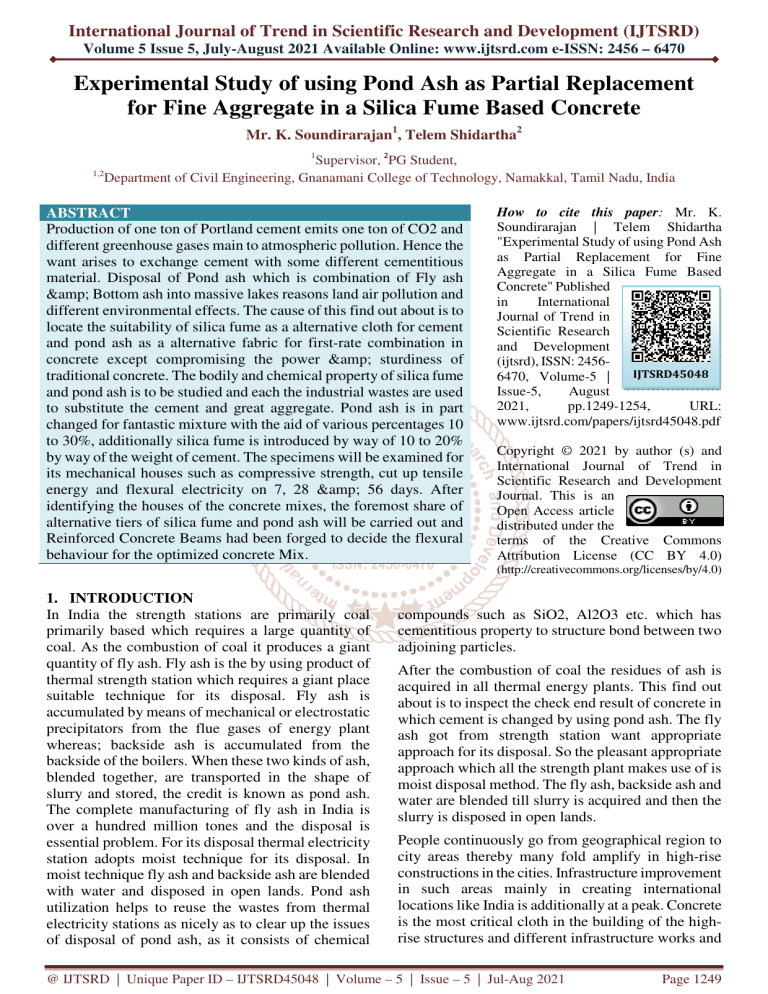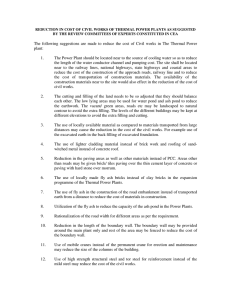
International Journal of Trend in Scientific Research and Development (IJTSRD)
Volume 5 Issue 5, July-August 2021 Available Online: www.ijtsrd.com e-ISSN: 2456 – 6470
Experimental Study of using Pond Ash as Partial Replacement
for Fine Aggregate in a Silica Fume Based Concrete
Mr. K. Soundirarajan1, Telem Shidartha2
1
Supervisor, 2PG Student,
1,2
Department of Civil Engineering, Gnanamani College of Technology, Namakkal, Tamil Nadu, India
ABSTRACT
Production of one ton of Portland cement emits one ton of CO2 and
different greenhouse gases main to atmospheric pollution. Hence the
want arises to exchange cement with some different cementitious
material. Disposal of Pond ash which is combination of Fly ash
& Bottom ash into massive lakes reasons land air pollution and
different environmental effects. The cause of this find out about is to
locate the suitability of silica fume as a alternative cloth for cement
and pond ash as a alternative fabric for first-rate combination in
concrete except compromising the power & sturdiness of
traditional concrete. The bodily and chemical property of silica fume
and pond ash is to be studied and each the industrial wastes are used
to substitute the cement and great aggregate. Pond ash is in part
changed for fantastic mixture with the aid of various percentages 10
to 30%, additionally silica fume is introduced by way of 10 to 20%
by way of the weight of cement. The specimens will be examined for
its mechanical houses such as compressive strength, cut up tensile
energy and flexural electricity on 7, 28 & 56 days. After
identifying the houses of the concrete mixes, the foremost share of
alternative tiers of silica fume and pond ash will be carried out and
Reinforced Concrete Beams had been forged to decide the flexural
behaviour for the optimized concrete Mix.
How to cite this paper: Mr. K.
Soundirarajan | Telem Shidartha
"Experimental Study of using Pond Ash
as Partial Replacement for Fine
Aggregate in a Silica Fume Based
Concrete" Published
in
International
Journal of Trend in
Scientific Research
and Development
(ijtsrd), ISSN: 2456IJTSRD45048
6470, Volume-5 |
Issue-5,
August
2021,
pp.1249-1254,
URL:
www.ijtsrd.com/papers/ijtsrd45048.pdf
Copyright © 2021 by author (s) and
International Journal of Trend in
Scientific Research and Development
Journal. This is an
Open Access article
distributed under the
terms of the Creative Commons
Attribution License (CC BY 4.0)
(http://creativecommons.org/licenses/by/4.0)
1. INTRODUCTION
In India the strength stations are primarily coal
primarily based which requires a large quantity of
coal. As the combustion of coal it produces a giant
quantity of fly ash. Fly ash is the by using product of
thermal strength station which requires a giant place
suitable technique for its disposal. Fly ash is
accumulated by means of mechanical or electrostatic
precipitators from the flue gases of energy plant
whereas; backside ash is accumulated from the
backside of the boilers. When these two kinds of ash,
blended together, are transported in the shape of
slurry and stored, the credit is known as pond ash.
The complete manufacturing of fly ash in India is
over a hundred million tones and the disposal is
essential problem. For its disposal thermal electricity
station adopts moist technique for its disposal. In
moist technique fly ash and backside ash are blended
with water and disposed in open lands. Pond ash
utilization helps to reuse the wastes from thermal
electricity stations as nicely as to clear up the issues
of disposal of pond ash, as it consists of chemical
compounds such as SiO2, Al2O3 etc. which has
cementitious property to structure bond between two
adjoining particles.
After the combustion of coal the residues of ash is
acquired in all thermal energy plants. This find out
about is to inspect the check end result of concrete in
which cement is changed by using pond ash. The fly
ash got from strength station want appropriate
approach for its disposal. So the pleasant appropriate
approach which all the strength plant makes use of is
moist disposal method. The fly ash, backside ash and
water are blended till slurry is acquired and then the
slurry is disposed in open lands.
People continuously go from geographical region to
city areas thereby many fold amplify in high-rise
constructions in the cities. Infrastructure improvement
in such areas mainly in creating international
locations like India is additionally at a peak. Concrete
is the most critical cloth in the building of the highrise structures and different infrastructure works and
@ IJTSRD | Unique Paper ID – IJTSRD45048 | Volume – 5 | Issue – 5 | Jul-Aug 2021
Page 1249
International Journal of Trend in Scientific Research and Development @ www.ijtsrd.com eISSN: 2456-6470
river sand is the important uncooked cloth used as
first-class aggregate in the manufacturing of concrete.
The natural sources of river sand are getting depleted
gradually. The demand for the safety of the herbal
surroundings and the ban on mining in some areas is
similarly annoying the trouble of availability of river
sand. At present, the building enterprise is plagued
with the shortage of this indispensable constituent
fabric of concrete. Therefore, in the existing
occasions of scant sources of river sand and growth in
infrastructure development, it turns into necessary
and extra considerable to locate out its alternative
fabric in concrete.
1.1. PRODUCTION OF BOTTOM ASH
Fig 1.1 Schematic Diagram of Production of Byproducts from Coal- fired Power Plant
1.2. OBJECTIVE OF THIS STUDY
The primary goals of the investigation are
To find out about the homes of industrial wastes
and their suitability in changing cement and great
aggregate
To learn about the impact of silica fume and Pond
Ash on the Workability of concrete.
To learn about the mechanical houses such as
compressive strength, cut up tensile strength,
flexural power of the Concrete with silica fume
and pond ash.
To look into the crack sample and flexural
conduct of the Reinforced Concrete beams with
foremost share of SF and Pond Ash.
2. MATERIALS
2.1. Cement
For this research work Ordinary Portland Cement
(OPC) 53 grade conforming to IS 8112 – 1989 was
used. American Society for Testing Materials(ASTM)
has designated ordinary Portland cement as Type I
cement used for general concrete constructions.
2.2. Coarse aggregate
Locally available coarse aggregates having the
maximum size of 20mm were used in the present
work. Testing of coarse aggregates was done as per
IS: 383-1970. The 20mm aggregates were firstly
sieved through 20mm
sieve. They were then washed to remove dust and dirt
and were dried to surface dry condition.
2.3. Fine Aggregate
The sand used for the experimental programme was
locally procured and conformed to grading zone III as
per IS : 383-1970 The sand was first sieved through
4.75 mm sieve to remove any particles greater than
4.75 mm and then was washed to remove the dust
2.4. Silica Fume
Silica fume also referred as micro silica or condensed
silica fume is another material that is used as an
artificial pozzolanic admixture. It is a product
resulting from reduction of high purity quartz with
coal in an electric arc furnace in the manufacture of
silicon or ferrosilicon alloy. When quartz are
subjected to 20000C reduction takes place and
SiOvapours get into fuels. In the course of exit,
oxidation takes place and the product is condensed in
low temperature zones. In the course of exit, Silica
fume rises as an oxidized vapour, oxidation takes
place and the product is condensed in low
temperature zones. When the silica is condensed, it
attains non-crystalline state with ultra fine particle
size. The superfine particles are collected through the
filters. It cools, condenses and is collected in bags. It
is further processed to remove impurities and to
control particle size. Condensed silica fumeis
essential silicon dioxide (SiO2) more than 90 percent
in non crystalline form. Since it is an airborne
material like fly ash, it has spherical shape. It is
extremely fine with particle size less than 1 micron
and with an average diameter of about 0.1 micron,
about 100 times smaller than average cement
particles. Silica fume has specific surface area of
about 20,000m2/kg, as against 230 to 300 m2/kg. The
use of silica fume in conjunction with super
plasticizer has been back bone of modern high
performance concrete. High fineness, uniformity,
high pozzolanic activityand compatibility with other
ingredients are of primary importance in selection of
mineral admixture. As Silica fume has the minimum
fineness of 15,000 m2/ kg, whereas the fumed Silica
has the fineness of 190,000 m2/g which is 6 to 7
times finer than Silica fume.
@ IJTSRD | Unique Paper ID – IJTSRD45048 | Volume – 5 | Issue – 5 | Jul-Aug 2021
Page 1250
International Journal of Trend in Scientific Research and Development @ www.ijtsrd.com eISSN: 2456-6470
3. EXPERIMENTAL PROGRAMME
3.1. CEMENT
Table 3.1 physical properties of cement
S.NO
Characteristics
Values
Standard value
1
Normal consistency
31%
2
Initial setting time(minutes) 36min
Not less than 30
3
Final setting time (minutes) 210 min
Not greater than
4
Fineness (%)
3.5%
<10
5
Specific gravity
3.15
6
Compressive strength
i
3 days
23.8 MPa Not less than 23 MPa
ii
7 days
34.2 MPa Not less than 33 MPa
iii
28 days
45.0 MPa Not less than 43 MPa
3.2. COARSE AGGREGATES
Table 3.2 Sieve analysis of 20mm aggregates
S.NO
Characteristics
Value
1
Type
Crushed
2
Maximum size
20mm
3
Specific gravity(20 mm)
2.8
4
Total water absorption (20 mm) 0.5%
5
Moisture content (20 mm)
-6
Fineness modulus(20mm)
7.68
3.3. FINE AGGREGATE
Table 3.3 Sieve analysis of fine aggregate
S.NO
Characteristics
Value
1
Type Uncrushed
(natural)
2
Specific gravity
2.60
3
Total water absorption
0.86%
4
Moisture content (20 mm)
-5
Fineness modulus
2.507
6
Grading zone
III
3.4. PHYSICAL PROPERTIES OF POND ASH
Table 3.4 Physical Properties of Pond Ash
S. No
Types of Test
Test results
1
Specific gravity
1.972
2
Bulk unit Weight
879 kg/m3
3
Fineness Modulus
2.39
4
Water Absorption
7.2%
3.5. CHEMICAL COMPOSITION OF SILICA
FUME
Table 3.5 Chemical composition of silica fumes
in %
SPECIFICATION
LIMITS
Form/colour
Powder/white/grey
SiO2
90%
H2O(moisture), max 3.0%
Bulk density
600kg/m3
4. TESTS ON FRESH CONCRETE
4.1. Slump Test
Fig 4.1 slump test
4.2. COMPACTION FACTOR TEST
Table 4.1 Slump values and compaction factor
values of partial replacement of Pond ash &
Silica fume in concrete.
Compaction
S.NO Identification Slump (mm)
factor
1
CS
83
0.85
2
M1
79
0.87
3
M2
83
0.94
4
M3
88
0.92
5
M4
91
0.90
6
M5
71
0.91
Fig 4.2 variation in slump values
@ IJTSRD | Unique Paper ID – IJTSRD45048 | Volume – 5 | Issue – 5 | Jul-Aug 2021
Page 1251
International Journal of Trend in Scientific Research and Development @ www.ijtsrd.com eISSN: 2456-6470
4.4. FLEXURAL STRENGTH TEST
Fig4.3 variation in compaction factor values
4.3. COMPRESSIVE STRENGTH
Table 4.2 Compressive strength for different mix
proportions
Compressive Strength N/mm2
S.NOIdentification
7 days 14 days 28 days
1
CS
23.02
29.14
36.92
2
M1
25.36
30.09
37.46
3
M2
27.25
32.54
38.88
4
M3
27.98
34.92
43.25
5
M4
26.27
32.14
35.87
6
M5
29.33
34.77
40.19
Fig 4.6 Casting of concrete beam specimens
Fig 4.7 Testing of concrete beams specimens
Fig 4.4 Experimental setup for Compressive
Strength
Fig 4.5 compressive strength test
Table 4.3 Flexural strength test for different
curing days
FLEXURAL STRENGTH, N/mm2
S.NO MIX
7 days
14 days
28 days
1
CS
3.20
5.60
6.20
2
M1
3.31
5.40
6.90
3
M2
3.38
4.21
6.80
4
M3
3.20
4.92
6.50
5
M4
3.42
5.80
7.20
6
M5
3.20
4.40
6.52
Fig 4.8 Flexural strength test for beam
specimens
@ IJTSRD | Unique Paper ID – IJTSRD45048 | Volume – 5 | Issue – 5 | Jul-Aug 2021
Page 1252
International Journal of Trend in Scientific Research and Development @ www.ijtsrd.com eISSN: 2456-6470
4.5. SPLIT TENSILE STRENGTH TEST
Table 4.4 Split tensile strength for different
curing days
SPLIT TENSILE STRENGTH IN
N/mm2
S.NO MIX
7 days
14 days
28 days
1
CS
2.18
3.7
4.2
2
M1
2.42
3.91
4.39
3
M2
2.57
3.51
5.52
4
M3
2.84
3.01
3.62
5
M4
3.17
4.21
5.85
6
M5
2.96
3.37
3.03
The cost of cut up tensile power and flexural
power additionally decreases at 28 days checking
out due to addition of pond ash and silica fume.
Beams of optimized combine exhibited
appropriate flexural behaviour which can be
accelerated by using growing the curing period.
REFERENCES
[1] Adakhar, “Compatibility of super plasticizer
slag added concrete in sulphate resistance and
chloride penetration”, Advances in Civil
Engineering Materials and construction
technology, 2001, volume 2 Iss 4 pp 33.
[2]
Ashis
Kumar
Beraetal,
“Compaction
characteristics of pond ash” Journal of
materials in Civil Engg, April 2007, volume4,
pp 349 -357.
[3]
Indian Standards 10262, Recommended
Guidelines for Concrete Mix Design, Bureau of
Indian Standards, New Delhi, 1982
[4]
Magudeaswaran. P, Eswaramoorthi. P,
“Experimental Investigation of Mechanical
properties on Silica fume and Fly ash as Partial
Cement Replacement of High Performance
Concrete” IOSR Journal of Mechanical and
Civil Engineering, Jun. 2013, Volume 6, Issue
4, pp57-63
[5]
Ranganath R.V, B. Bhattacharjee and S.
Krishnamoorthy, “Influence of size fraction of
ponded ash on its pozzolanic activity” Cement
Concrete Res, 1994 vol.5, pp 749-761.
[6]
Vijaya Sekhar Reddy, I.V.Ramana Reddy,
N.Krishna Murthy, “Predicting the Strength
Properties of High Performance Concrete using
Mineral and Chemical Admixtures” ARPN
Journal of Science and Technology, January
2013, vol. 3, No. 1 pp.36-38.
Concrete Mix-4 containing 15% SF &amp; 20%
Pond Ash suggests most price of flexural energy
at 28 days.
[7]
Virenda Kumar, “Compaction and permeability
study of pond ash” Journal of The Institution of
Engineers (India), May 2004, vol.2, pp 31-35.
The most beneficial proportion of substitute
degree of SF for cement is 15% and pond ash for
high-quality mixture is
20% barring
compromising the workability and mechanical
houses of concrete.
[8]
R. S. Bang, Y. M. Ghugal, I. K. Pateriya
“Strength Performance of Pond Ash Concrete
International Journal of Earth Sciences and
Engineering” , Feb 2012, Volume 05, No. 01,
P.P. 180-185
As the share of alternative of pond ash increases,
the weight of the specimens decreased due to low
density of pond ash.
[9]
S. A. Haldive, Dr. A. R. Kambekar,
“Experimental Study on Combined Effect of
Fly Ash and Pond Ash on Strength and
Durability of Concrete”, International Journal
of Scientific & Engineering Research, May2013, Volume 4, Issue 5, p.p 81-86
Fig 4.9 Split tensile strength for different curing
days
5. CONCLUSIONS
This learn about is targeted on comparative find out
about of the use of silica fume and Pond Ash to
produce Eco-friendly concrete. The following
conclusions are derived based totally on the
experimental study.
Addition of pond ash extensively reduces the
workability of concrete mixes whereas the
addition of expanded proportion of silica fume
improves the workability.
Concrete Mix-3 containing 12.5 SF&amp; 15%
Pond Ash yielded maximum compressive strength
It is seen that there is discount of compressive
electricity of concrete mixes at 7 days of curing.
At 28 days, the compressive energy of the mixes
receives improved.
@ IJTSRD | Unique Paper ID – IJTSRD45048 | Volume – 5 | Issue – 5 | Jul-Aug 2021
Page 1253
International Journal of Trend in Scientific Research and Development @ www.ijtsrd.com eISSN: 2456-6470
[10]
Arumugam K , Ilangovan R , James Manohar
D, “A study on characterization and use of
Pond Ash as fine aggregate in Concrete”
International Journal Of Civil And Structural
Engineering,2011, Volume 2, No 2, p.p 466477
[15]
M. P. Kadam, DR.Y.D. Patil “Effect of coal
bottom ash as sand replacement on the
properties of concrete with different w/c ratio”
International Journal of Advanced Technology
in Civil Engineering, ISSN: 2231 –5721,
Volume-2, Issue-1, 2013.
[11]
Bharathi Ganesh, H. SharadaBai, R. Nagendra
and B.K. Narendra, “Characterization of Pond
Ash as Fine Aggregate in Concrete”
Proceedings of International Conference on
Advances in Architecture and Civil
Engineering (AARCV 2012), June 2012, Vol.
1, p.p. 119-125
[16]
RemyaRaju, Mathews M. Paul & K. A.
Aboobacker “Strength performance of concrete
using bottom ash as fine aggregate”
International Journal of Research in
Engineering & Technology (IMPACT: IJRET)
ISSN(E): 2321-8843; ISSN(P): 2347-4599 Vol.
2, Issue 9, Sep 2014, 111-122.
[12]
Prof. P. P. Bhangale" Study of Pond ASH
(BTPS) Use as A Fine Aggregate in Cement
Concrete "- Case Study, International jornalof
latest trends in Engg. And Technology, Vol 2,
Issue 2, March 2013.
[17]
[13]
Jay Patel, Kunal Patel, Gaurav Patel
“Utilization of pond fly ash as a partial
replacement in fine aggregate with using fine
fly ash and alccofine in hsc” IJRET:
International Journal of Research in
Engineering and Technology 2013
Aparna K. A., Dr. V. Ramesh “Comparative
Study of Fly Ash and Pond Ash on
Compressive and Flexural Strength of
Concrete” International Journal of Civil and
Structural Engineering Research 2015 ISSN
2348-7607 Vol. 3, Issue 1
[18]
Perumal, K., Sundararajan, R., 2004. Effect of
partial replacement of cement with silica fume
on the strength and durability characteristics of
high performance concrete. In: 29th Conference
on Our World in Concrete & Structures: 2526
August 2004, Singapore.
[19]
Kumar, P. R., Rao, C. B. K., 2002. Cost
effectiveness of silica fume concrete design
mixes. In 27th Conference on Our World in
Concrete & Structures, 2930 August 2002,
Singapore.
[14]
ArunkumarDwivedi, Dhiraj Kumar S. Lal
“Influence of Addition of Pond Ash as Partial
Replacement with Sand and Cement on the
Properties of Mortar” International Journal of
Innovative Technology and Exploring
Engineering (IJITEE) ISSN: 2278-3075,
Volume-2, Issue-4, March 2013.
@ IJTSRD | Unique Paper ID – IJTSRD45048 | Volume – 5 | Issue – 5 | Jul-Aug 2021
Page 1254




